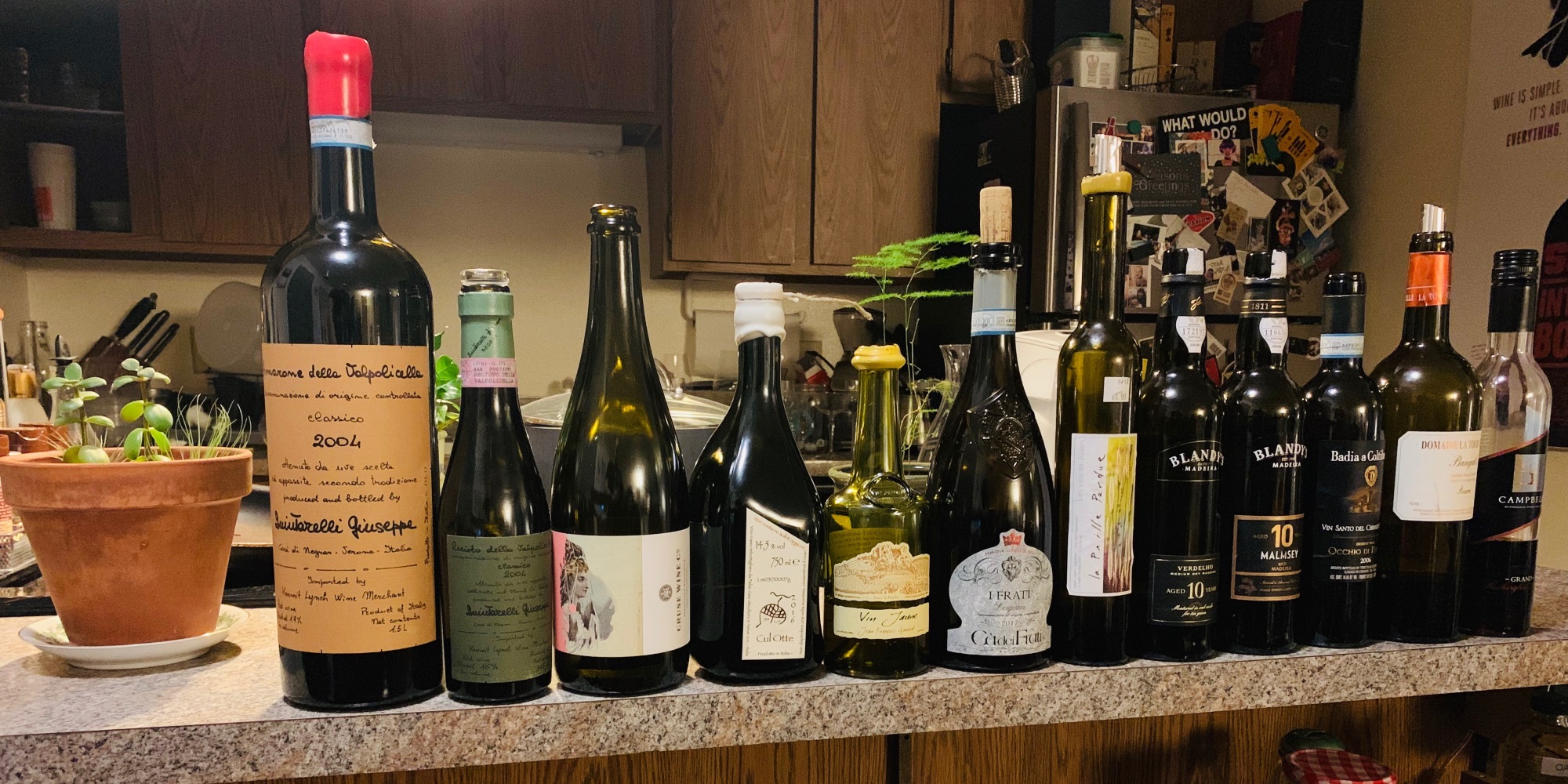Giuseppe Quintarelli, Amarone + Recioto, Archetype Tasting
Wine Tasting, March 27th, 2019
Wines:
- 2004 Giuseppe Quintarelli, Amarone della Valpolicella Classico, Veneto, IT, 1500mL
- 2004 Giuseppe Quintarelli, Recioto della Valpolicella Classico, Veneto, IT, 375mL
- 2018 Cruse Wine Co.
- 2016 Fabio Gea, Cul Otte, Vino Rosso, Neive, Cuneo, IT
- 2007 Jean François Ganevat, Vin Jaune, Jura, FR
- 2017 Cà dei Frati, I Frati, Lugana, Veneto, IT
- 2007 Julien Labet, La Paille Perdu, Vin de Paille, Jura, FR
- NV Blandy’s, 10 Year Medium Dry Verdelho Madeira, PT
- NV Blandy’s, 10 Year Rich Malmsey, Madeira, PT
- 2006 Badia a Coltibuono, Occhio di Pernice, Vin Santo del Chianti Classico, Toscana, IT
- NV Domaine La Tour Vieille, Banyuls Reserva, Roussillon, FR
- NV Campbells, Grand Rutherglen Muscat, Victoria, AU

Unique Winemaking in Northern Italy
These terms apply to some of the special wines made in Veneto near the shores of Lake Garda, between the peaks of the Vicentine Alps and coast of the Adriatic Sea.
Veneto
Italy’s most productive wine region, surpassing both Sicily and Puglia in output. Many everyday wines are produced here from high-yielding vines, although some amazing specialties are found across a multitude of styles.
The region has seven provinces, each named for a capital city. Quality wines are found mainly in Verona, Treviso, Padua, and Vicenza. In addition to the most famous styles of Valpolicella and Amarone, other notable wines include:
- Conegliano Valdobbiadene Prosecco Cartizze, sparkling Glera
- Lessini Spumante, sparkling Durello
- Colli Eugani Fior d’Arancio, sparkling Moscato Giallo
- Lison Friulano, white Tai-Friulano
- Bianco di Custoza, white Garganega + Trebbiano Toscana
- Soave Classico Superiore, white Garganega
- Bardolino Chiaretto, rosato Corvina Veronese
- Piave Malanotte, red Raboso Piave
- Recioto di Gambellara, passito Garganega
- Breganze Torcolato, passito Vespaiola
Verona
A province within the Veneto region, with a capital city that shares the same name. This province contains the famed Valpolicella, Bardolino, Soave, and Lessini appellations.
IGT
Indicazione Geografica Tipica. A term for Italian wine based solely on geography, without style constraints, corresponding to the EU term PGI, or Protected Geographical Indication. Used by producers to create generic low-cost wines, or special wines with personality that exist outside of traditional DOCG rules. An example of the latter is Quintarelli’s IGT Veneto “Primofiore”, an airy blend of Cabernet grapes with Corvina.
DOC(G)
Denominazione di Origine Controllata e Garantita. This term combines a restricted geographic area with traditional style rules. Specifics of viticulture, grape variety, winemaking, and aging are delimited, regulated by a regional Consorzio. DOC wines are similar, but (arguably) do not carry the stated “Guarantee” of DOCG quality.
Passito
Dried grape wine. These styles have existed since Greek times, and are widely prized across Italy, as well as France, Spain, and even Austria. Nearly every Italian region features local passito styles, made in white and red expressions alike. Passito wines typically begin with healthy, ripe fruit, and are not affected by Botrytis.
Appasiamento
The process of drying grapes, which leads to passito wines. This drying may be carried out on the vine itself, or in rooms, attics, or straw mats in the sun. In France, the process is called Passerillage.
Recioto
A famous type of passito wine which comes from the Verona area of the Veneto region specifically. The term originates from “orecchio” meaning ear, in reference to the outer lobes of a grape cluster, which develop a higher level of ripeness than the rest of the bunch. These grapes are cut separately, and transferred to “Fruttai” rooms for drying. Recioto is a celebrated style in Valpolicella, Soave, and Gambellara. The Recioto style is an ancient precursor to Amarone, a relatively new creation in the region.
Valpolicella
The area within the Verona province, which produces still red wines, in addition to Amarone and Recioto. Corvina is the most favored grape, next to Rondinella and Corvinone. Molinara has been a traditional blending partner, but lacks the nobility of the others.
Amarone
Named for “Amaro” meaning bitter, this is one of the most powerful red wines in the world. It is a wine that begins life with plans to become a sweet Recioto, yet escapes that fate, fermenting to near-dryness. The wine’s origin dates to the mid-20th century, occurring from an accidental batch of Recioto that fermented dry, although its first creator is debated. Quintarelli and Bertani represent more traditional producers, with Dal Forno Romano breaking trends with modern idiosyncrasy.
Ripasso
Translates to “Re-Passed”. This in-between style bridges Valpolicella with Amarone. First, the free-run juice from Amarone ferment is racked off the skins, leaving its unpressed berries behind. From there, the lighter Valpolicella wine is added, and a second fermentation initiates, with Amarone skins giving a boost of intensity. A portion of Amarone wine may even be added to the Ripasso from there as a bonus.

Attendance:
- Michele D.
- Nick D.
- Jeremy E.
- Xin F.
- Jonelle Y.
- MC Z.

